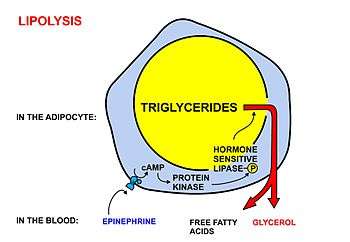Lipolysis
Lipolysis /lᵻˈpɒlᵻsɪs/ is the breakdown of lipids and involves hydrolysis of triglycerides into glycerol and free fatty acids. The following hormones induce lipolysis: glucagon, epinephrine, norepinephrine, ghrelin, growth hormone, testosterone, and cortisol. These trigger 7TM receptors (G protein-coupled receptors), which activate adenylate cyclase. This results in increased production of cAMP, which activates protein kinase A, which subsequently activates lipases found in adipose tissue.

The cAMP activates a protein kinase, which phosphorylates and thus, in turn, activates a hormone-sensitive lipase in the fat cell.
This lipase cleaves free fatty acids from their attachment to glycerol in the fat stored in the fat droplet of the adipocyte.
The free fatty acids and glycerol are then released into the blood.
Monoglycerides are hydrolyzed by monoglyceride lipase.[1] The activity of hormone sensitive lipase is regulated by the circulation hormones insulin, glucagon, norepinephrine, and epinephrine, as shown in the diagram.
Triglycerides are transported through the blood to appropriate tissues (adipose, muscle, etc.) by lipoproteins such as Very-Low-Density-Lipoproteins (VLDL). Triglycerides present on the VLDL undergo lipolysis by the cellular lipases of target tissues, which yields glycerol and free fatty acids. Free fatty acids released into the blood are then available for cellular uptake.[2] Free fatty acids not immediately taken up by cells may bind to albumin for transport to surrounding tissues that require energy. Serum albumin is the major carrier of free fatty acids in the blood.[3] The glycerol also enters the bloodstream and is absorbed by the liver or kidney where it is converted to glycerol 3-phosphate by the enzyme glycerol kinase. Hepatic glycerol 3-phosphate is converted mostly into dihydroxyacetonephosphate (DHAP) and then glyceraldehyde 3-phosphate (GA3P) to rejoin the glycolysis and gluconeogenesis pathway.
While lipolysis is triglyceride hydrolysis (the process by which triglycerides are broken down), esterification is the process by which triglycerides are formed. Esterification and lipolysis are, in essence, reversals of one another.[4]
Currently there are four main non-invasive body contouring techniques growing in the aesthetic medicine for reducing localized subcutaneous adipose tissue: low-level laser therapy (LLLT), cryolipolysis, radio frequency (RF) and high-intensity focused ultrasound (HIFU).[5][6]
Insulin action in the mediobasal hypothalamus has been shown to suppress lipolysis due to lower sympathetic nervous outflow to white adipose tissue.[7] The regulation of this process involves interactions between insulin receptors and gangliosides present in the neuronal cell membrane.[8]
References
- ↑ Zechner R., Strauss J.G., Haemmerle G., Lass A., Zimmermann R. (2005) Lipolysis: pathway under construction. Curr. Opin. Lipidol. 16, 333-340.
- ↑ King, Michael W. "Oxidation of Fatty Acids". Retrieved 9 April 2012.
- ↑ Tom Brody, Nutritional Biochemistry, (Academic Press, 2nd edition 1999), 215-216. ISBN 0121348369
- ↑ Baldwin, Kenneth David Sutherland; Brooks, George H.; Fahey, Thomas D. (2005). Exercise physiology: human bioenergetics and its applications. New York: McGraw-Hill. ISBN 0-07-255642-0.
- ↑ Kennedy, J.; Verne, S.; Griffith, R.; Falto-Aizpurua, L.; Nouri, K. (2015). "Non-invasive subcutaneous fat reduction: A review". Journal of the European Academy of Dermatology and Venereology. 29: n/a. doi:10.1111/jdv.12994. PMID 25664493.
- ↑ Mulholland, R. Stephen; Paul, Malcolm D.; Chalfoun, Charbel (2011). "Noninvasive Body Contouring with Radiofrequency, Ultrasound, Cryolipolysis, and Low-Level Laser Therapy". Clinics in Plastic Surgery. 38 (3): 503–20, vii–iii. doi:10.1016/j.cps.2011.05.002. PMID 21824546.
- ↑ Scherer T., O'Hare J., Diggs-Andrews K., Schweizer M., Check B.,Lindner C.; et al. (February 1, 2011). "Brain Insulin Controls Adipose Tissue Lipolysis and Lipogenesis". Cell Metabolism. 13 (2).
- ↑ Herzer, Silke; Meldner, Sascha; Gröne, Hermann-Josef; Nordström, Viola (2015-10-01). "Fasting-Induced Lipolysis and Hypothalamic Insulin Signaling Are Regulated by Neuronal Glucosylceramide Synthase". Diabetes. 64 (10): 3363–3376. doi:10.2337/db14-1726. ISSN 0012-1797. PMID 26038579.
External links
- Lipolysis at the US National Library of Medicine Medical Subject Headings (MeSH)
.svg.png)